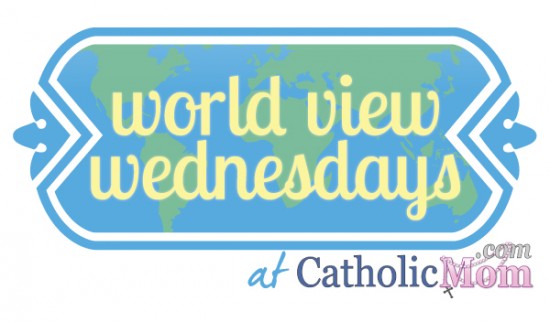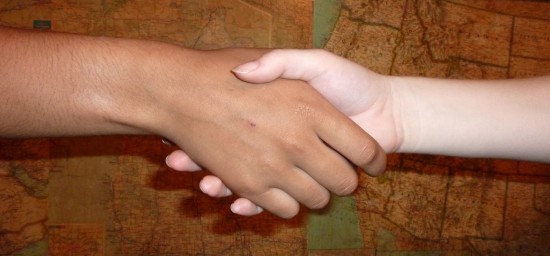
Can you hold the world in your hands? Literally? Can you take pen to paper and map the world, complete with nations’ borders, capital cities, and features?
Taking in daily news, we see thousands lining streets in Seoul, Korea, for Pope Francis’ historic visit; Ebola patients in Africa lying under tents awaiting treatment; tanks rolling on Ukraine/Russia borderland; religious refugees on the move in Syria and Iraq; conflicts in Afghanistan, Somalia and other hotspots world-wide: the stories are gripping, overwhelming, begging action and prayer.
How do we and our children make sense of it all? Do we move beyond headlines to prayer and action? Pope Francis warns against too exclusively wrapping ourselves in a culture of comfort, entertainment, and sports. We can make a difference in the world, but we have to stir ourselves to action.
One way to sharpen our vision and help heal our aching world might surprise you – we can study maps. It’s a lot more fun and productive than folding one.
Our Catholic Faith takes on rich hues and textures as celebrated within a vast array of cultures and regions. One impact of attending solemn Masses and Papal audiences at St. Peter’s in Rome, or buoyant World Youth Days from Australia to Brazil, is experiencing a spectrum of ethnicities. It helps to put peoples in context if we have a working knowledge of their neck of the woods. How can we be concerned and educated about global issues if we don’t know what the world looks like?

As a tutor for home school Classically Catholic Memory and Classical Conversations co-ops, I saw children as young as four and five years old mapping the continents. It doesn’t take long for even the youngest to start drawing rough map lines and treating landmarks like old friends. It all begins by sketching circles on a page and identifying each continent’s location. From there, detailed map drawing unfolds.
Cartography, studying and making maps, was once staple fare in education, and it fits in nicely with a Classical approach to learning – an approach beloved by Catholic monks through the Middle Ages and back through millennia, to ancient Greece and Rome. But today, many schools have sidelined Classical disciplines, including cartography. If you or your children were handed paper and pen today, could you draw the outlines and identify the United States of America, and all the Continents and their nations?
My personal goal is to one day put stick to sand at the beach, and draw the world. I would be so pleased if my children could do that, too. Why not challenge our households to map-drawing goals? Make it a family affair. Whoever can draw the basic outline of the world and identify nations and highlights (make a list), is relieved dishes duty for a week!
I know children who, after diligently tracing and studying maps for 10-15 minutes a day, can fill a blank sheet of paper with an astonishing sketch of the world in just moments. And they do so eagerly. Mapping the world is satisfying, a goal worth having, and an achievement to last a lifetime.
People in Classical education refer to foundational facts serving as mental “pegs” on which to hang future knowledge. When you meet someone, you memorize that person’s face and name. When you visit his or her home, you suddenly know so much more about your new friend, by seeing him or her in context. Carrying a mental picture of nations and their neighbors breeds familiarity and stirs interest. Memorizing our world’s features, like learning those of a beloved friend, provides pegs on which to hang future knowledge. It leads to a deeper understanding of various peoples, their differences, amazing cultures, and events.
We’re never too old to learn and share our enthusiasm. After missionary priests in and from India became friends, I bought a vivid map of that sub-continent and studied it daily. I learned to form my hand into a “V” to mimic India’s landmass, and point to various regions as I shared stories with friends and family. I had to laugh when I caught myself making that “V” and identifying landmarks in the shower! After a while, I owned a mental picture of this land, its major cities, mountain ranges and deserts. Now, when I hear of monsoon flooding near Pakistan or a cyclone heading west from the Bay of Bengal, I can imagine the layout of these regions and the impact. When I pray, I often “see” India in my mind from a bird’s-eye view, as I plead God’s blessings on this land, and on my friends and their people.
Did you ever see a bird watcher spot and recognize a rare bird? The thrill of discovery and of naming the bird and its habits, is just like the rush that comes with identifying and naming nations on a map, and learning to draw them. I know that, because I’ve seen children in action who have learned to really love mapping the world. Their enthusiasm is contagious. I’ve experienced that little punch of adrenaline myself.
So, we can help our families learn and pray about current events and God’s children, through the long lost art of studying and drawing maps. Open the Bible, and you’ll find fabulous maps of the Holy Land. Display a globe. Add a few satellite images to your walls and post colorful maps in primary spots. Give everyone a few weeks to study, and then hold that map-drawing competition for all ages in your household.
Make merry use of maps, and the world will seem a little smaller…something you and your family can hold within your clasped and praying hands, as you plead that God might hold the world in His.
Copyright 2014, Marianna Bartholomew
About the Author

Guest
We welcome guest contributors who graciously volunteer their writing for our readers. Please support our guest writers by visiting their sites, purchasing their work, and leaving comments to thank them for sharing their gifts here on CatholicMom.com. To inquire about serving as a guest contributor, contact editor@CatholicMom.com.


.png?width=1806&height=731&name=CatholicMom_hcfm_logo1_pos_871c_2728c%20(002).png)
Comments